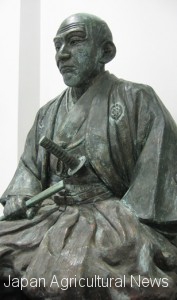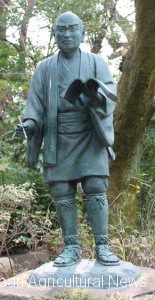Mutual aid illuminating feet
As economic globalization progresses, mutual assistance based on the spirit of cooperation is indispensable for maintaining and developing vulnerable communities. From the Edo period when the cooperative’s sprouts were visible to the present age, when society was in turmoil, cooperatives became “resilience” and demonstrated their power. We light the footsteps of pioneers of Japanese cooperatives.

Statue of Yugaku Ohara located at Yugaku Ohara Museum (= provided by the Museum at Asahi City, Chiba Prefecture)
In Asahi City, Chiba Prefecture, there is a museum of Yugaku Ohara who launched the “Senzokabukumiai (ancestral share association)”, which can be said to be the prototype of nogyokyodokumiai (agricultural cooperatives). In Odawara City, Kanagawa Prefecture, there is a museum of Sontoku Ninomiya who created the “Hotoku thought” by adding “Sincerity” and “hard-working” to the economy concept. The number of people who visit both museum has increased in recent years.
Ohara was a rural leader who started consumption association and joint purchasing business based on harmony between morality and economy. 4,500 people a year, including outside the city, visit to the museum. Elementary school students also visit each year as part of class. Children said, “I did not know that such a wonderful person lived in my hometown. ” Also, more than 10,000 people each year visit to Sontoku Ninomiya Museum. Why do a lot of people seek two persons’ footprints that raised “Cooperation”?
◇
In rural areas of the Edo period, the houses had to form village communities gathered. Currently, they are 50 to 80 units of the villages called “Oaza” or “Hansei-son” (Clan district villages). They were not only places of life for farmers, but also places of production. It served as the basic administrative unit for the lords to grasp farmers. Villagers helped each other from farming to ceremonial occasions at the time, living in close contact with each other.
According to Professor Naoshi Watanabe of Graduate School of Hitotsubashi University who is familiar with the history of modern Japan, there was “Yui (bind)”, one of the mutual assistance systems for farming works. At the time of planting and harvesting of rice, farmers were required a lot of labor. Because it was impossible for family members alone, farmers families worked with each other. If 4 families create one “Yui”, Mr. A’s rice planting work can be helped by the other 3 families in full force. The next day Mr. B’s rice fields can be helped. Thus, farmers families interchanged their labor force each other flexibly. We can understand that agriculture in the Edo period was based on mutual aid of villagers.
When they rebuilt their house and change the roof, they cooperated not only in the labor force but also in terms of materials. Forests were not only privately owned, but also shared by villages as lots of common areas (entry areas). People could cut out timber from the entry area and use it.
Some of the farm animals essential for agriculture were also shared by groups organized by families. In such group, for example, someday Mr. A plowed using exclusively cattle domesticated by the group, and the next day Mr. B plowed by using the cattle.
Nengu (tax) was imposed on village units. Total amount of nengu was shown to myoshu (headman), and then individual amount of nengu (tax) was decided by villagers in consultation. Myoshu (headman) collected individual nengu (tax). When there were any farmers unable to pay individual nengu (tax), myoshu (headman) payed temporarily their portions and payed full amount of total nengu (tax).
The role of safety net at the time of turbulence
At the end of the Tokugawa period, merchandise and money economy had penetrated rural villages. While cotton’s price became high in the market, farmers making wheat self-sufficiency used to stop making wheat and begin making cotton, so as to buy wheat by revenue of cotton. If farmers spin the thread with cotton, made it into woven fabric with increasing added value and sold it themselves, they could make more money. In addition to agriculture, farmers came to incorporate industrial and commercial methods, and their range of sideline business expanded.
There are two aspects of commodity and money economy. Owing to it, society as a whole became rich, but the disparity in the individual home expanded and as a result some houses collapsed. But people in Edo era did not dare to abandon collapsed farmers as a self-responsibility. The human connection such as “Goningumi” (5-person group), relatives, and the community, played the role of a safety net to avoid large collapse of society, and led people to the modern.
Professor Watanabe stated that “The ways of Sontoku Ninomiya and Yugaku Ohara were superior. But they were not only created by their hand. They were also created based on the base of various mechanisms villagers had built over the years. 2 persons learned the excellent of them and exceeded the level of them. That is great meaning of their ways. ”


